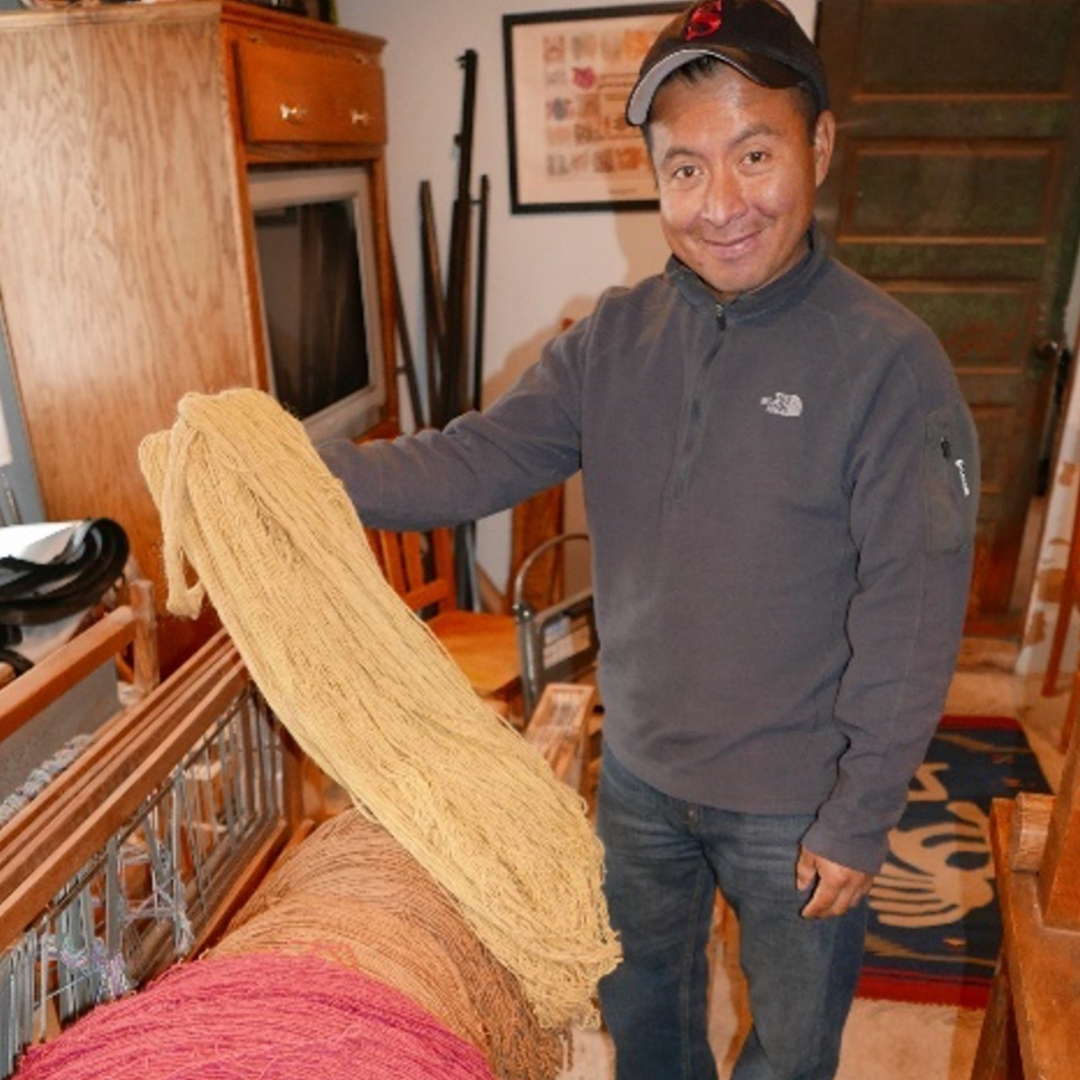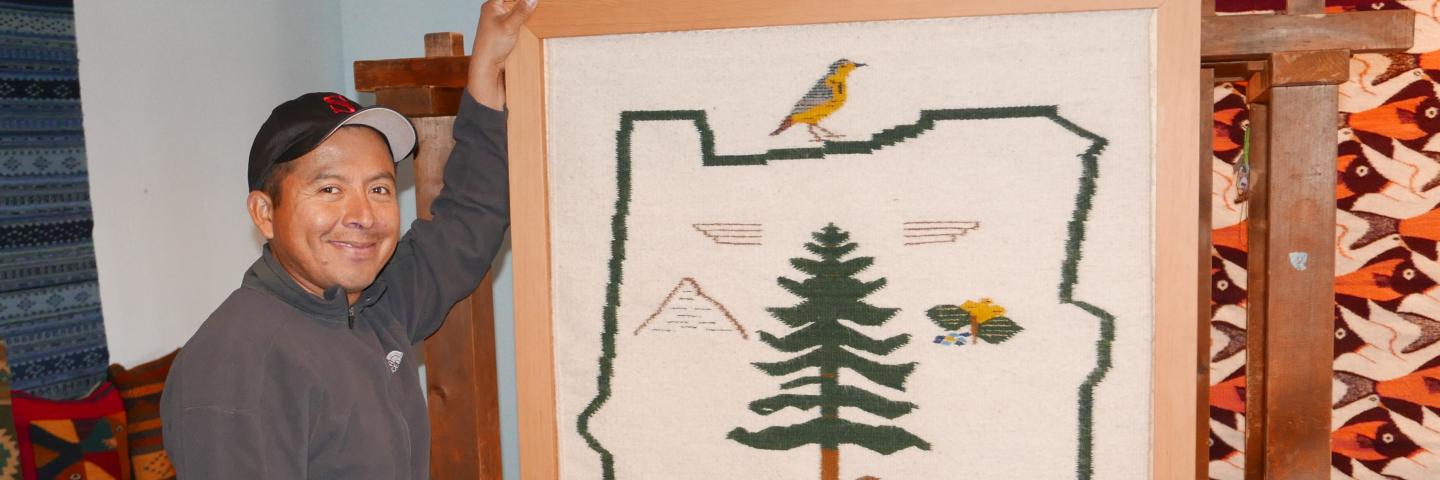 | Traditional Skill/Art Craft: Zapotec weaver Years Awarded: 2018, 2020 Contact Information: Phone: (971)235-1290 Email: bautistas.art@gmail.com Website: https://bautistaweaving.com/ |
ARTIST BIOGRAPHY
Francisco Bautista was born in the town of Teotitlán de Valle in Oaxaca, Mexico. He grew up learning to weave from his father and grandfather, both of whom made a living weaving. In 2003, he and his wife moved to Sandy, Oregon, where they began weaving and taking their rugs to Saturday Market in Portland and other shows in Oregon. As a member of the Portland Handweavers Guild, he has demonstrated Zapotec weaving at several fairs and shows, including Art in the Pearl.
He has taught workshops about the Zapotec method of natural dyeing in Sandy and Bend, Oregon. In 2017, he shared his Zapotec weaving tradition with non-Zapotec immigrants from Mexico through a program sponsored by the Sandy Public Library at Sandy Vista Apartments. Additionally, he volunteers in many demonstrations and teaching programs throughout the community.
APPRENTICE BIOGRAPHY - David Bautista 2020
David Bautista is the son of Francisco Bautista. He grew up surrounded by the art of weaving and learned how to weave from his father and mother. He wove his first rug when he was 7 years old and when he was 10, he visited his family in Mexico where he learned to make bobbins from his grandparents.
In 2019, he wove 30 small weavings for a gallery show at the Columbia Center of the Arts Gallery in Hood River, Oregon, where he sold all 30 pieces. He aspires to learn as much as he can about the art and history of weaving to revive the spark of Zapotec weaving in his community and to teach future generations the tradition.
APPRENTICE BIOGRAPHY - Cinthya Bautista 2018
Cinthya Bautista Lopez is the fourteen-year-old daughter of Francisco Bautista. She comes from a family of Zapotec artists who are native to Oaxaca, Mexico. She learned the Zapotec weaving tradition from her family. Her goal is to bring together her skills as an artist in other mediums and art forms to weaving in order to bring Zapotec weaving back into the spotlight. She wishes to continue weaving and, in the future, travel around Oregon and beyond to teach the art form to others.
Q+A WITH THE MENTOR ARTIST
Describe your traditional art.
Body
Weaving is an important and beautiful part of the Zapotec culture. Most of the symbols used in traditional Zapotec weaving come from ancient designs that are found in the ruins of Mitla and Mont Albán in the Oaxaca valley in Mexico. My great grandfather and my grandfather farmed as well as doing weaving and selling rugs to middlemen for a living. My father weaves and sells his rugs directly to customers.
Most of the rugs my family weaves include traditional Zapotec symbols which they arrange as they weave. Like other Zapotec weavers, they also make woven replicas of the paintings of modern artists (including Picasso, Miro, and Diego Rivera) to meet the demands of their customers. My family in Mexico must sell most of the rugs they weave in order to pay for food and other necessities, but whenever they can, they keep a rug to hang on their wall. We are all very proud of our regions and our family’s weaving heritage.
How did you come to learn this tradition?
Body
I am a fourth-generation weaver in my family. I grew up sitting under my father’s loom as he wove, and I watched both my father and my grandfather weave. At the age of seven or eight, I began helping my dad wind his bobbins. I learned to twist the warp yarns into fringe as a finish for both ends of the rug. I learned to weave all the traditional designs by observing my father and grandfather and eventually I was able make my own rugs. I worked on the weaving tasks in the morning and went to school in the afternoon. Every weekend my dad and I took our weavings to markets in different towns and we sold them to the tourists who came from all over the world. As the eldest son in my family, I held great responsibilities in Oaxaca. It was my job to teach my younger brothers about weaving, starting with winding bobbins and making fringe.
Why is this cultural tradition important to your community?
Body
Most of my work uses traditional Zapotec symbols and I dye all of my yarns using mostly dyes that come from plants and insects. My family has also created a few of our own new designs that we can weave using our traditional techniques. We want to demonstrate our love for our new home in America and have created original rug designs that show the beauty of Oregon and Washington.
Although I no longer live in Oaxaca, when I weave, I feel that a part of my home in Oaxaca remains within me. I feel proud that I can use this weaving tradition from Mexico to help make my way in my new home country. I think it is important for my family to share our Zapotec weaving with people in the United States, especially in the Portland area, which is our new home.
Experience/Honors
Body
Oregon Art Beat TV show (October 1, 2020)
American Craft Council Art show Baltimore, Maryland (February 2020)
American Craft Council Art Show San Francisco, California (Virtual show) (Agugust 2020)
Weaving Guilds of Oregon 2018 Traveling Show (Bend, Portland, Roseburg, Baker City, Salem (received Best of Show award)
Bellevue Art Museum juried show (July 2016, 2017, 2019)
Salem Art Fair (juried) (July 2016, 2017, 2019)
Whatcom Museum Foundation show in Bellingham (Sept 2017, 2018)
Columbia Center of the Arts in Hood River (Dec 2016 & 2017, Jan 2019)
Best of Northwest art show, Seattle (March 2017, Feb 2019)
Rain Spark Gallery, Lake Oswego (Nov 2017, Feb 2020)
Visit OFN's Culture Keepers Roster to learn more about the artist.
Traditional Arts Apprenticeship Program
More OFN programs
OFN main page
